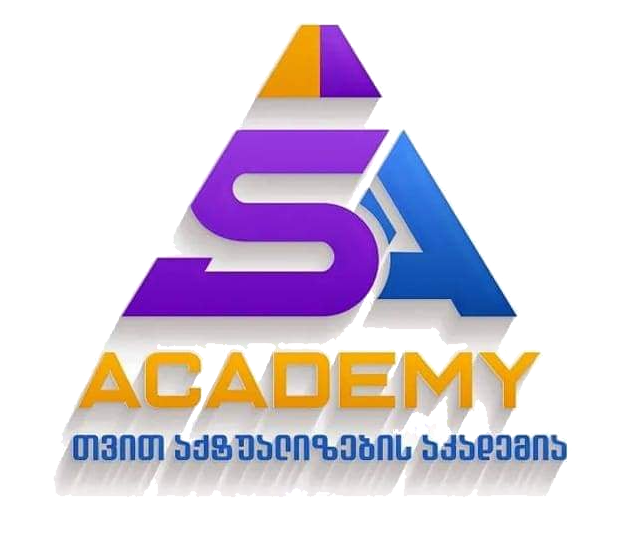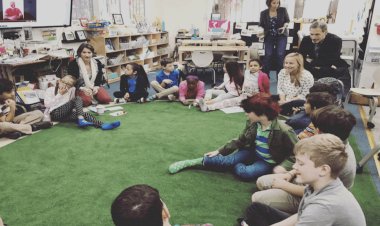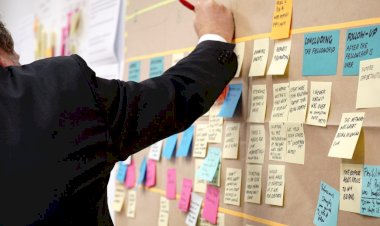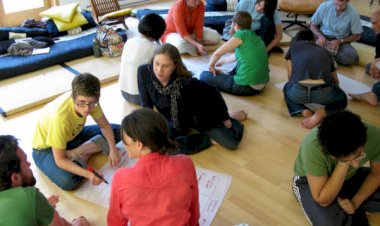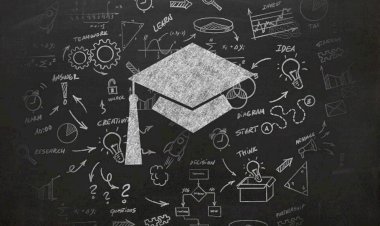SELF-ACTUALIZED TEACHERS ENHANCE STUDENTS’ LEARNING RESPONSIBILITIES BY CREATING STUDENT-CENTERED CLASSROOM ENVIRONMENT (GEORGIAN CASE)

Authors: Nino Tvaltchrelidze, Nana Aleksidze
2019
Abstract
In this era of challenges, of constant competition in every field of humans’ life, people have become more motivated to acquire all the needed skills to meet and satisfy the 21st century demands. The process of adaptation to the new challenges, learning all the skills for winning the competition comprises all those principles which are based on the process of humans’ self-actualization. The main concern of the human beings became to be well-aware of their talents and abilities and to maintain their potential application for successful realization. Education as the important aspect of the humans’ development plays an indispensable role in not only educating, but also motivating humans to be self-actualized and self-realized. Motivated and self-actualized teachers and instructors make their learners find their role in their learning, accept their responsibilities and the desire to be empowered and self-actualized. On the basis of human nature of the learners, they are confident only then when they know why the teachers want them to be active, collaborative, and responsible and why they make students understand the benefits those skills can give. Motivated teachers motivate students, make them see and feel their role and responsibilities in their learning and make participation in the classroom life collaborative.
Key words: Self-actualization; Student-centered education; Learning Responsibilities; Humanistic Education
Introduction
The 21-st century world is more demanding for changes and restructuring. These demands require from educational institutions to create and implement effective approaches and ways for meeting the needs of students’ meaningful learning and teachers’ productive work (Bush & Bell, 2002, p. 30).
Taking the student-centered approach in education is considered to be the way for meeting the productive and positive outcomes of the learners’ learning and teachers’ teaching. Teachers in this sense are considered to be effective managers of the classroom, who are generally engaged in the process of implicit theorizing and deciding how to create and formulate effective student-centered classroom policy to respond to the learners’ needs and the major aspects of their learning: personal abilities and potential development. Teacher as a manager should address to apply two necessary factors while managing classroom (Bush & Bell, 2002, p. 30):
- Diagnosis: the process of assessing the situation and highlighting the main issues
- Evaluation: determining the most appropriate solution to the problem
In the process of policy-making teacher acts like a manager and encourages students to be active in participating in the policy-making process. They should pass several stages of effective planning and designing (Bush & Bell, 2002, p. 45):
- Creating contributive conditions of the effective learning and learner-oriented teaching
- Ensuring the clear and explicit, well-planned links, either direct or indirect between the classroom activities related to the actual problems and supporting learning and teaching.
- Making strong association between knowledge and skills of the classroom members and learners.
- Providing conditions to make well defined and acceptable links between students’ capacities and their self-management abilities and learning outcomes.
Teacher within the frames of student-centered classroom management is a transformational leader, motivating learners to do more than they originally are expected to do in any on the following ways (Bush & Bell, 2002, pp.53-54):
- Raising learners’ level of awareness and conscious about the importance of the needed and effective outcomes and leading them to seek the ways of reaching those outcomes.
- Getting them to be self-actualized and self-confident, to transcend their own self-interest for the sake of their individual and team demands. Motivate them to become synergic to achieve planned goals and to fulfill created vision.
- Altering their needs and managing their gratification on the principles of Maslow’s (1943 as cited in Bush & Bell, 2002) Hierarchy, expanding their scope of self-actualization and needs to meet their lower needs to the highest level. Teacher managing to create the necessary opportunities for that purpose, motivates learners to enrich their working and learning experience and pursues more challenging and meaningful tasks and goals.
- Satisfying demands of being educational leader and effective manager in the student-centered classroom, by providing directions and exerting advice on the development of the learners’ learning, teachers’ teaching, making curriculum and syllabus relevance to educational management purposes, diagnosing educational problems within the classroom and encouraging the students’ life-long learning capacities.
Student-centered classroom management requires from teachers to be effective leaders and ensuring the conditions for active learning. Student-centered teacher organizes classroom members’ continuous reflection on their actions, their learning and makes the activities as a daily practice, facilitates the improvement of learners’ work and participation in the process. Student-centered classroom management requires from teachers to take the new set of leadership beliefs and competences that can transform the old and traditional teacher-centered approach and all its attached constraints into the new student-centered approach, facilitate educational changes, develop an appropriate classroom environment for students and for teachers to work and to learn and to develop effectively (Bush & Bell, 2002, pp. 53-54).
Creating the student-centered environment is one of the most important means optimizing the students learning. Educators need to apply new and existed methods, practices and principles which develop skills, knowledge and attitudes that will increase the learners’ learning achievements and teacher’s productivity. On the basis of human nature of the learners, they are confident only when they know why the teachers want them to be active, collaborative, responsible and why they make students understand benefits those skills can give. By creating meaningful learning, sharing control, keeping balance of power, realizing their roles, taking their personal and learning responsibility, being collaborative and cooperative, teachers will manage to optimize the students learning and lead them to reach the state of being lifelong learners.
Problem Statement
In the country like Georgia, people face many life challenges connected to economical, psychological and physiological aspects of their life. Country’s geopolitical, ethnical and cultural factors make its citizens to handle many problematic issues. Country regained its democracy 25 years ago, it is characterized with multi-ethnicity and is multi-cultural, multi-religious. This reality makes Georgia choose one of the most democratic way towards its citizens and to be tolerant to all its citizens; multi-ethnicity, culture and religious. Education is the sphere where the focus is on the human and his/her personal and professional growth to meet all the needs what the life would place towards them (students) in future. Well-designed educational process and well-trained, motivated teachers can enable their students to learn and to make realization of their knowledge, to open their scope of mindfulness and become independent member of the society. To get success and make effective educational process teachers need to help their students to be interested in their learning, to be motivated participating in activities and to be actualized for their future self-realization. To reach those aspects students need to be well prepared and well-aware of their learning, to find meaning in their learning. But still there are problems of having not prepared, not motivated students in classes, as Weimer (2002, pp.95-118) states there are several reasons for why today’s students come to school less prepared than they did in the past:
- They lack solid basic skills
- They lack confidence in themselves
- They do not feel responsibility as learners for their learning
- They lack motivation and courage
- They seek easy options
- They have emotional distress and serous personal problems etc.
Humanistic Concept in Education
Student-centered approach comprises all the methods and strategies in education which are oriented on the person, individual growth and the actualization of the humans to prove their being in the life, in the society. One of the approaches in education is humanistic conceptions in education which makes its theory to be based on the person and its growing potential to be fully functioning human (Rogers, 1969; Maslow, 1970).
Humanistic education (also called person-centered education) is an approach to education based on the work of humanistic psychologists A. H. Maslow and Carl Rogers.
The basic concern of the humanistic theory is the human potential oriented for growth. Freedom of personal choice and motivation. The humanistic approach places a great deal of emphasis on students' choice and control over the course of their education. Student-centered education contains broad psychological aspects. These aspects do a great favor to the implementation of the effective activities and management not only for the educational psychology but also for day-to-day school and classroom life. This is effective in all ages of the school education but especially productive for the teen-age students.
Student-centered learning can, thus, be seen as a form of self-actualization, it contributes to psychological health of the students and creates psychologically safe climate in the classroom. Yet while self-actualization may be seen as the primary goal, other goals linked to the main purpose of students’ self-actualization are also around. These include a sense of accomplishment and the controlling of impulses.
One of the most persuasive exploration of a humanistic orientation to learning came from Carl Rogers and Abraham H. Maslow. Their theories are devoted toward applying the results of their psychological researches on the person-centered teaching where empathy, caring about students and genuineness on the part of the learning facilitator were found to be the key traits of the most effective teachers. Carl Rogers (1969) suggests the following elements for being involved in significant and meaningful process of learning:
- Personal involvement, the whole person in both feeling and cognitive aspects being in the learning event.
- Self-initiation, even when the impetus or stimulus comes from the outside, the sense of comprehending it comes from within.
- Evaluation by the learner, when the learners know what they really want to know and when they feel that the teaching delivered by the teacher meets their needs and is meaningful.
Essence in meaning, when such learning takes place, the element of meaning to the learner is built into the whole experience.
Humanistic educators believe that both feelings and knowledge are important to the learning process. It is believed that the overall mood and feeling of the students can either hinder or foster the process of learning. Unlike traditional educators, humanistic teachers do not separate the cognitive (thinking) and affective (emotional) domains. These domains form students’ skills of critical thinking, problem solving, practical abilities, value creation, communication, motivation and perceptions.
Effective, self-actualized teachers can significantly enhance student learning. Humanistic approach places teacher as a facilitator who enables students to be active and elicits their knowledge and inner potential to the right direction for their self-actualization.
Good student-centered teachers while facilitating their students’ learning should provide several factors (Rogers, 1969):
- Response to student feeling
- Use of student ideas in ongoing instructional interactions
- Discussion with students (dialogue)
- Praise of students
- Congruent teacher talk (more relevant and much less ritualistic)
- Tailoring of contents to the individual student's frame of reference (explanations created to fit the immediate needs of the learners)
- Smiling with students.
Humanistic teachers believe it is important for students to be motivated and engaged in the material they are learning, and this happens when the topic is what students need and want to know. In the mid-1950s, humanistic psychologist Abraham Maslow created a theory of basic, psychological and self-fulfillment needs that motivate individuals to move consciously or subconsciously through levels or tiers based on our inner and outer satisfaction of those met or unmet needs.
Discussion
Adopting the student-centered approach gives the new possibilities and obligations to the learners. As Doyle (2008) states students in the first sight neglect student-centered teaching, being afraid of:
- taking responsibilities for their learning
- being actively engaged in the process of teaching and learning
- identifying their role in the educational process and classroom activities for all those reasons as Doyle states, students need to see benefit of student-centered approach , being interested and motivated to take their part in the whole educational process, being active learners. If not making learners being encouraged and motivated, instead of excitement and joy they would feel fear, stress and anxiety.
On this basis teachers’ major role and challenge is to make them feel comfort, ease their stress, encourage them to assume their responsibility and their role as being active receiver of the knowledge and not the mere passive listener (Doyle, 2008). Students don’t like taking learning risks, as learning is the live process. It means also new challenges and some risks of being either successful or failed, either win or lose. Students with more or less self-awareness and self-confident always experience the feeling of fear of failure. More skillful, more actualized and empowered learners they become, less would be their fear of novelty and of new expectations. Students do not want to make extra effort that means that students unless they see the real need and benefit of the approach, never are motivated to make extra effort. If they feel that what they make is enough and are not made or required to make more they will never make more effort. Making them understand the concept of the student-centered teaching, making them participate and let them feel their active and important role in the learner-centered classroom management, will do a great favor in engaging them in the process and making more work taking more responsibility. When students feel confidence and are well aware of their learning abilities, when they see their work assessed and appreciated constructively without criticism, they become encouraged to make more and take more.
The reason why the learners become minimalistic, Zull (2002. p. 53 as cited in Doyle, 2008, p. 31) suggests:
- Learning the process how the human brain works and how the learners’ (as humans’) brain works, which deals to the psychological and physiological aspects of education.
- Maintaining the organized plan of motivating learners, activating the aspects of intrinsic motivation
- Focusing on creating and suggesting the right system of reinforcement to the learners for maintaining effective and meaningful learning
According to Zull (2002, p. 53 as cited I Doyle, 2008 p.31) only intrinsic motivation is not enough for constructing the effective and meaningful lessons but this aspect is still very important as intrinsic motivation deals with the emotional side of the learners’ nature and their drive to be motivated.
It is the instructor who motivates students with encouraging their active participation in the classroom management to create conductive learning outcomes. When the learning is result-oriented and when the result is planned beforehand to maintain the learner oriented teaching, conducting the meaningful learning process, this is what really works, pushes and drives learners to learn, through their understanding that learning is inevitable for being realized, actualized and self-directed lifelong learner.
Recommendations
For improving these challenges there are some actions to be taken, there should be held some institutional and local, classroom change and polices to be made. Getting students to take part in creating the classroom rules and inner regulations motivates them to be active in the classroom life, be initiative in proposing their views. The collaboratively created rule-based approach in the student-centered teaching increases the intrinsic motivation of the learners to learn. Students feel confident and highly motivated realizing their responsibility in the classroom processes when they are part of the whole process and creators of classroom rules, environment and climate. These factors promote learners having learning responsibility and realizing this responsibility. Taking the learner-centered approach means to change the classroom climate that serves two objectives:
- First, creating the climate for meaningful learning, positively affecting the learners learning ability
- Second, creating the climate and environment without or with very few rules, learners are free to do what they need to do, for their effective learning, personal development, self-actualization, preparing themselves being future and further learners, promoting life-long, self-directed learning, which give the positive learning outcome and motivates learners to take active responsibility for their learning.
Teachers taking the student-centered approach, aim to prepare their learners for being self –regulated learners. They should create such conditions that focus to encourage, motivate, actualize and satisfy students to accept and sustain their responsibility for the various components of their own learning. Weimer (2002) suggest the principle of Responsibilities for Teaching and Learning Process, Student-centered teachers follow this principle to make it possible to create comfortable, positive and fully acceptable climate for the learners and for the teachers within the student-centered classroom management (Weimer, 2002). This principle refers to dealing the students immaturity and irresponsibility for learning and the possible and needed actions to be made for dealing the problem. Teachers should work hard, accumulating their knowledge, experience, conduct the literature review to commit actions setting the parameter and conditions for real, meaningful learning, perceiving the reality so as the teachers are also very responsible for their learners’ learning. But the decisions to learn should be made by the students. Teachers in this sense can motivate, encourage and influence on the learners, though the responsibility on making decisions are to be taken only by the learners. Teachers can lead students to learning, but never force them. Teachers try to show the real picture of the learning process, but students should perceive it and take the charge of it. Instructor guides the students by using some regulations, rules, requirements, guidelines, makes the learners to turn from the passive absorber of information more active receivers of knowledge, convincing the students that they need more. But beyond all those activities, methods and approaches teachers use, they still cannot apply the full control. Where the teachers’ responsibility ends up, the students’ responsibility starts.
How can we guess where ends the teachers’ responsibility and where starts the students’ one, whether it is enough, when it is already fulfilled? These questions are answered by the students’ behavioral response. If they refuse taking responsibility it will be their own choice. Teacher may be careful and attentive observers of their learners’ actions. There is not a clear and fixed measurement where to draw the line between teacher’s and student’s responsibilities. Teachers should clarify and explicitly describe what they mean under the students’ responsibility and be always ready for the students’ intriguing questions. Once the students interest is active and caught, then the teachers become like fish in the ocean and fully free to lead them to all those needed learning recourses learners require.
Learners are those who are really responsible for their learning, teachers do a great service to create the relevant teaching and learning, learner-centered conditions and maintain policies accordingly, practicing their work and enabling students fully perceive and understand their learning responsibilities, to receive and sustain those responsibilities.
According to Weimer’s (2002) concept of student-centered teaching and responsibilities for learning, the above mentioned principle helps teachers to prepare the strong ground directed to the development of the students to become mature, responsible learners. Instructor creates and consistently transfers the responsibility from the teacher to the learners. Teachers should never be obliged to give more burden of responsibility to students than they can handle. Learners need to realize and understand their role in the learning process and assume their responsibility in it. Students should admit their major role in creating and keeping performing and maintaining such climate in the student-centered classroom, which will be conductive to them and to their mates learning. Students should be led to understand that there exists the casual relationship between their committed actions and consequences of their learning. This motivates students to be decision-makers to perceive their role in decision-making process and they will resist any kind of prevention from that direction.
Conclusion
In student-centered teaching the active focus goes on learning. Learning as Goldberg (2002 as cited in Doyle, 2008, p. 5) defines, by giving it more technical explanation, is the process going in the human organism, exploring new pattern and exposed to it and to the outside signals which comes form that new patters, turns into the process of formation of the synaptic contact of biochemical and electric properties gradually changing in complex and distributed constellations. Bjork ( 1994, p.187, as cited in Doyle, 2008, p. 5) defines learning as the condition or state to perceive and process the new information to use it for solving task in a different context from that which was originally learned. These definitions make it clear that learning without the object, without the learner, without their perception and understanding, cannot be formed as a learning process. Learning is not only receiving or absorbing information passively, but it is process of active and effective application of the knowledge. For promoting the student-centered approach there should be connection between the practice and the reality already discovered and experienced. The bridge between the reality, research based data, practice and theory is hardly needed to be built. The question is who should do and match this connection. This is the responsibility for everyone and for no one definitely, as all those personalies being in the educational process are equally responsible to do the task.
One thing is clear, teaching needs to be refined, to be restarted and refreshed, and to be changed in very fundamental ways. People often discover this process disturbing, as they would face the challenge of long-held assumptions and old habited, even traditional ways of thinking about managerial, instructional and experiential issues in the field of education. But this so called difficulties and even assumed disagreement may work beneficially and even spark the motivation, courage to increase the will, make research, perform the concrete steps of activity, get acquainted to the theory deeper, reflect upon the practice, develop the self-reflection and growth, which would lead to building the better, profound and strong bridges between research, theory, practice. “Much more of what we do in the classroom needs to be based on what we know”. (Doyle, 2008, p. xiv). The research has the most significant tool of getting the authentic outcome and answer to the research question, this is asking questions. According to Weimer (2002), putting the learning questions defines the paradigm of teaching and learning better. If all the educators say yes to the question, where they are interested in the learning outcome and the learning quality of their students, then all what is known and would be known about teaching easily and clearly bridges these two super important components of education: learning and teaching. Adopting the student-centered orientation circles attention definitely on learning, what , how and under which conditions do the students are learning, how students are absorbing, retaining and applying their learning , how the current process of education encourages, prepares the student for future, life-long learning (Weimer, 2002, p. Xvi). Learning itself denotes the concept of abstraction as content of information, notion, concept, view and ideas, theory and practice; assumptions where the direct objects are students applying it. What is needed it is to make clear and steady link, real and authentic connection between teaching and learning on the conceptual plane where all the needed instructional policies and practices together with the theoretical part makes the direct impact on how much and how well our students learn. The Student-centered approach orients towards learning the students’ needs, their interest demands, compatibility their learning to their demands and future careers, comprising creating the sound and competitive market place of educational product quality on the bases of relevant educational management fostering the subtle and sophisticated , student-centered climate, producing the best product and promoting the desired outcome.
References
Bush, T. & Bell, L. (2002). The Principles and Practice of Educational Management. University of Leicester. UK London: Paul Chapman Publishing.
Doyle, T. (2008). Helping Students Learn in a Learner-Centered Environment. Virginia: Stylus Publishing, LLC. Sterling.
Maslow, H. (1970). Motivation and Personality. Harper & Row Publishers.
Rogers, C. (1969). Freedom to Learn. Columbus & Ohio.
Weimer, M. (2002). Learner Centered Teaching. San Francisco: John Wiley & Sons.
